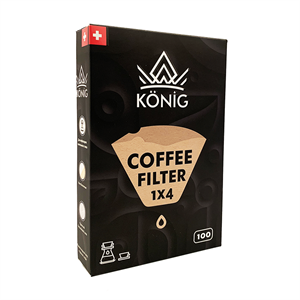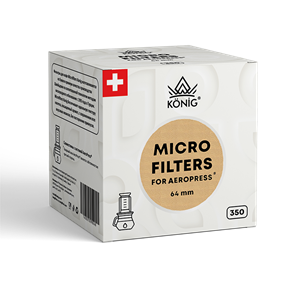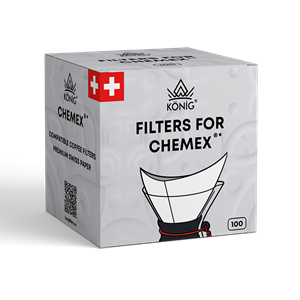Review of coffee filters, search for a compromise
As you know, regardless of the method of preparation, brewing coffee invariably begins with filtration. But when choosing a filter, there may be some difficulties associated with finding a device with an optimal set of advantages and disadvantages. In this article, we will look at all types of filters, while evaluating their positive and negative properties.

Paper products have an excellent ability to retain small coffee particles, but have a short service life. Metal filters are durable, but they give out a solid drink that requires immediate consumption in order to avoid the appearance of bitterness due to the extraction of particles entering the cup.
Types of filters
All coffee filters can be divided into two categories: built-in and replaceable. The built-in ones are implemented directly into the equipment and are not replaceable components. They require cleaning after each use, and in case of breakage, they must be disposed of together with the coffee machine.
Disposable devices can be produced of paper, fabric, nylon and metal. Single-use filters are disposed of after each batch of coffee is made, and reusable ones are cleaned and returned to work.

All filters, without exception, have the same functions, which includes the separation of solid insoluble coffee particles. Some have the additional ability to retain coffee oils. Others are made in a special form that contributes to the saturation of coffee with oxygen. However, for all their similarity in terms of capabilities, some filters cope with their tasks perfectly, but many do not meet the expectations.
Replaceable filters
Replaceable devices are suitable for both home and commercial use. Some of them have to be replaced with new ones, but there are also those that are enough to rinse after use.
Paper
Disposable paper filters are most in demand in tandem with Bonavita and Hario V60 funnels, drip coffee machines, aeropress, kalita, chemex, as well as other types of brewing equipment. KONIG FILTER PAPER produces most of existing paper coffee filters.
The paper does not pass the smallest coffee particles and oils. The finished drink is characterized by rich aroma, lightness of the body and purity of taste.
Such filters do not need cleaning, as they are disposed of immediately after use. This approach is convenient, but costly: you need to have a sufficient supply of filters and constantly replenish it.
From the point of view of ecology, there are also some nuances. Responsible suppliers bleach paper with oxygen, avoiding use of chlorine, which creates a problem due to the huge amount of waste. Paper filters are compostable and biodegradable.

Nylon
Drip coffee machines are often equipped with reusable nylon filters. They are recommended for brewing coarse coffee, since the porous material passes fine particles into the cup. A different course of extraction reduces the saturation of the finished drink.
Such filters are convenient to use, but they are not without drawbacks. They should be thoroughly rinsed after each brewing and changed after 60 applications. As a rule, nylon devices are simply thrown away, harming the environment, because their decomposition takes from a hundred to a thousand years.
Metal
Reusable metal filters are purchased for funnels, chemex and aeropress. The seepage of small coffee particles and oils causes the production of coffee of increased potency with prolonged extraction. It should be drunk fresh, before the appearance of bitterness.
It is necessary to wash metal filters after each use. It is allowed to use a dishwasher. Their purification will not be difficult, since the material does not absorb moisture and oils. The service life of a metal filter is measured in several years.

Fabric
Reusable fabric filters are relevant for brewing coffee in a funnel, drip coffee maker and chemex.
Made of cotton, hemp or muslin, the devices are able to change the taste of coffee. Enlarged pores poorly retain coffee dust, creating a slight sediment in the cup. Prolonged extraction gives the drink bitterness, so it should be consumed immediately after coffee preparation.
Used fabric filters are not thrown away, but washed without the use of chemicals that can spoil the taste of coffee.
This type of device causes minimal harm to the environment, as it is disposed of in small quantities. The filter is changed every three to four months. Over time, coffee dust accumulates and gives the drink foreign flavors.
There is no ideal filter among the listed ones, since each of them has its pros and cons.
Built - in
The Hario "Kafeor" funnel is a popular device equipped with a built-in filter that does not require the purchase of additional filtration devices.
There are two types of funnels – open and purover. The open version is installed directly on the cup. The purover is equipped with a special container, but if necessary, you can use a regular cup of a suitable diameter. Coffee in a funnel with a built-in filter is prepared in the same way as in a conventional funnel.

Equipping the Hario "Kafeor" funnel with a built-in stainless steel mesh filter prevents small coffee particles from entering the cup without interfering with the passage of oils. Due to this, the finished drink has a brighter taste and aroma compared to coffee made in an open funnel.
The durable and lightweight device is widely in demand among travelers and tourists. It is easy to clean under running water or in the dishwasher.
For all its advantages, the "Kafeor" with a built-in filter is not without drawbacks. After a time a contamination of the filter leads to a change in the taste of coffee and the funnel becomes unusable. The developers of coffee-making devices do not stop working on creating a universal model.
Ceramic Filter
The vast majority of replaceable and built-in filters are made of metal, plastic and paper. However, there are models made of less common materials that are not inferior to the usual ones in their functionality.
The ceramic device, which has a resemblance to charcoal, has a long service life. It is produced by a small Japanese company Kyuemon, specializing in the manufacture of tableware. Manual production improves the quality of the product: it does not bend and does not crumble.
The device exists in two variants. The round one is designed to make one cup of coffee, and the V-shaped one is designed to make three at the same time. The filter is used as an independent element that does not require auxiliary devices, such as a funnel. It is placed on a mug or other container. If one of the users finds it inconvenient, he can always use a complete ceramic dripper with a hole at the bottom. This will make the task easier.

The duration of filtration greatly affects the taste and aroma of the drink. The Kyuemon filter has the smallest holes evenly spaced on the surface. Such a constructive solution protects against the ingress of coffee particles up to 50 microns in size into the cup. This helps to reduce bitterness and acidity, eliminate the formation of a dusty and tart body, and also contributes to the maximum disclosure of sweet notes.
The strength of the drink is manageable due to the correct choice of grinding and changing the volume of water used. According to the manufacturer's recommendations, this filter is optimal for brewing medium and medium-coarse coffee.
Currently, we do not know of any other filter that does not require replacement. Rinse it periodically with hot water. Ceramics are perfect for brewing coffee, black and green tea.
Conclusion
The filter is the most important component for making a coffee, responsible for its taste and purity. It is very difficult to find an ideal device: some distort the taste, others are not too convenient to use, and others require additional costs. We believe that in future optimal solution will definitely appear.



